Landmark Films Of The 20th Century – 1930-1939
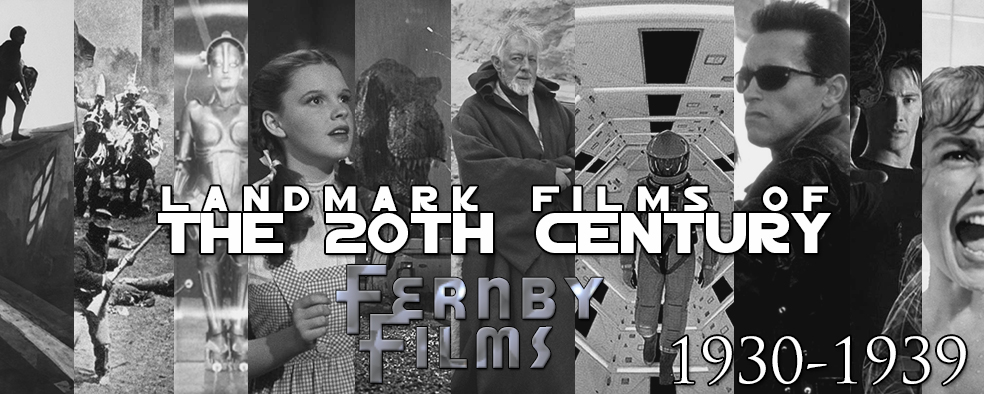
In this, the fourth of our ten-part series on landmark films of the 20th Century, we identify films that set new benchmarks and new ways for film-makers to tell their stories – from editing, to sound, to visual effects, the 100 films we’ve unearthed are considered either classics (or should be) that changed the landscape of film forever. The films listed herein represent annual landmark achievements in cinema – they may not be the “best” films of that year, but they represent a leap forward in cinematic technique that is worth considerable attention.
The period of the 1930’s and early 1940’s has come to be known as “The Golden Age Of Hollywood”; more classic films were made during this period than in any other, in particular 1939, perhaps the single greatest year the cinematic medium ever had in terms of creativity and financial success. Following the stock market crash of 1929, and the world plunging into the Great Depression, it seems unlikely that films would go from strength to strength as a way for folks to throw off their cares of the time – unemployment at an all time high, looming war in Europe thanks to the rising Nazi Party in Germany, and a generally dismal outlook on future prospects made for pretty compelling reasons to stay home. However, the 1930’s are regarded by most avid film fans as one of the most productive and entertaining periods in Hollywood’s history, featuring the rise of new film genres, the Studio System, and the birth of wide-scale short-form animated films which paved the way for the Looney Tunes.
Part IV – 1930-1939
1930. All Quiet On The Western Front.
The outright classic anti-war film sparked a flurry of controversy at the time – namely in German, where it was banned, due to its depiction of German soldiers in World War I questioning why war was necessary, which rubbed the nascent Nazi Party the wrong way…. – remains an outright classic of the medium to this day. The first hugely successful war film talkie of the day, the film’s message resounded with an audience coming out of the horrors of the first world war (and about to descend into a second…) and it became the second highest grossing film of that year. Essential viewing for any student of cinema, All Quiet On The Western Front blasted into 1930 and continues to be a potent, magnificent dissection of combat and the horrors of wartime.
Also in 1930: the first talkie-gangster film debuted with Warner Bros Little Caesar, starring Edward G Robinson; Marlene Deitrich debuted in The Blue Angel, Greta Garbo appeared in her first talkie, Disney’s Pluto appeared in his first animated short, and the first big-screen appearance of Marion Morrison, aka John Wayne, arrived in The Big Trail.
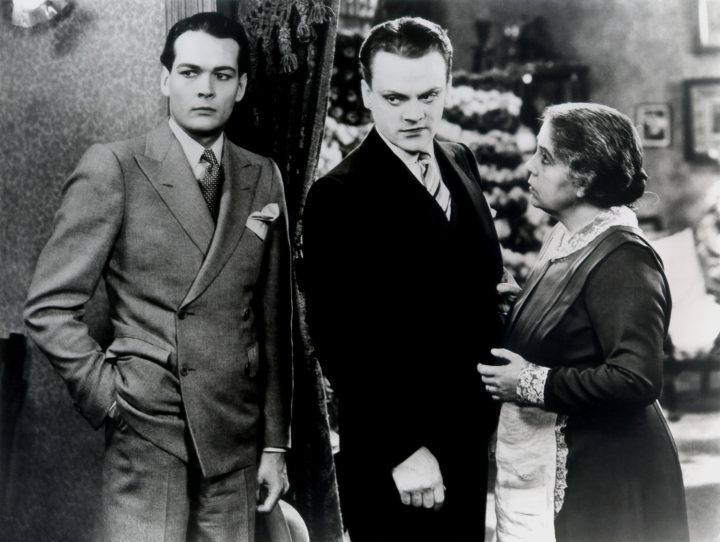
1931. The Public Enemy.
The Gangster film genre continued to remain popular into 1931 with the hugely successful James Cagney flick The Public Enemy (also co-starring Jean Harlow in an early role). According to my research the film’s depiction of sexuality, violence and criminality was responsible for the increased push towards what would be known as the Hayes Code, a restrictive rulebook for Hollywood film-makers which arrived in 1934. Cagney’s performance in the film typecast him for almost his entire career as a thuggish, brute character in similar roles, while the film’s infamous “grapefruit scene”, in which Cagney’s character smashes half a fruit into the face of Mae Clarke, has become one of the Golden Age’s most controversial moments. As one of the earliest (and best) of the genre’s classic works, The Public Enemy is one hell of a landmark in Hollywood’s chequered history.
Also in 1931: Horror films came of age in 1931, with the triple-threat release of Universal’s Dracula and Frankenstein in short succession, as well as Rouben Mamoulian’s Dr Jekyl & Mr Hyde, which saw Frederic March snag Best Actor for his work as the dual character. Frankenstein would become 1931’s highest box office earner, while Dracula would enter pop-culture mythology thanks to Bela Lugosi’s oft-imitated depiction of Bram Stoker’s literary icon. The Gary Cooper-starring flick City Streets contained Hollywood’s first voice-over, while Fritz Lang’s influential M came along depicting serious psychological issues in a considerably serious manner. French film A Nous La Liberte became the first foreign language film to receive an Oscar nomination.
1932. Shirley Temple
One of the most successful child stars of all time, Shirley Temple, appeared for the first time in 1932’s Runt Page, a one-reel flick the first of many before her feature film début in The Red-Haired Alibi, also in 1932. Temple’s career would last until the mid-60’s, although her post-adolescence output was considerably sparse than that of her childhood. At one point in her early career, Temple was being paid $1000 per week, as well as $15,000 per film completed, a remarkable sum for a child barely in double digits. Her enormously successful feature film Bright Eyes, which spawned the radio-hit song “The Good Ship Lollipop”, arrived in 1934, and the actress was awarded a special Juvenile Oscar in 1935. Instantly recognisable with her curly mop-top of hair and her cheeky grin, Temple’s face became iconic throughout the 1930’s before her career waned and eventually she left acting altogether.
Also in 1932: The first of six Johnny Weismuller Tarzan film, Tarzan The Ape Man, arrived, the magnificent Grand Hotel from MGM won Best Picture, Disney début their first Silly Symphonies short Flowers & Trees, which also became the first animated short to win the Academy Award in that category, and Victor Halperin’s White Zombie, considered the first true zombie film, came along.
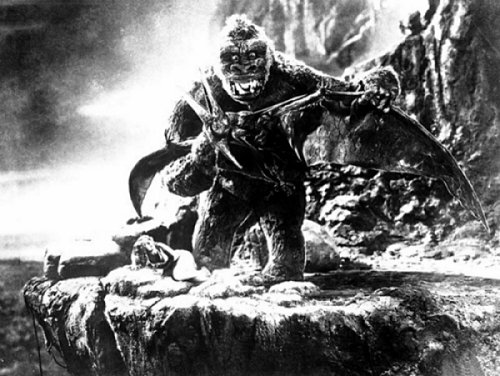
1933. King Kong.
If you need the influence of King Kong’s impact on cinema explained to you you’ve been living in a hole for your entire life. Undoubtedly one of the greatest films ever made, the enduring story of the beauty – Fay Wray – and the beast – Kong – has inspired generations of film-makers ever since. Kong’s legacy became entrenched in Hollywood’s firmament through technical innovation and cinematic wizardry, not to mention a brisk, compelling story featuring emotive impact and destructive action which continues to wow audiences even today. While most people marvel at Kong’s visual aesthetic, the film should also be noted for being one of the first to mix dialogue, sound and music onto three separate tracks, enabling sound designer Murray Spivak to balance the effects and music, as well as dialogue, so they wouldn’t overwhelm the others. Kong was also the first talkie film to record a specific orchestral score with thematic material, rather than inorganic background music.
Also in 1933: Fred Astaire and Ginger Rogers appeared together for the first time in Flying Down To Rio, which was only Astaire’s second film; Czech film Extacy, which starred a very young Hedy Lamarr (then billed as Hedwig Keisler), contained the first non-pornographic depiction of a female orgasm, as well as nudity, and sexual intercourse. Katharine Hepburn’s third film, Morning Glory, saw her snag the first of four Academy Awards for Best Actress, while the world’s first-ever drive-in theatre opened on June 6th, in New Jersey. Warner Bros 42nd Street landed and revitalised the musical movie genre, thanks to choreographer Busby Berkeley, while Mae West’s continued bawdy roles began to provoke outcry enough to lead further towards censorship of the film industry as a whole.
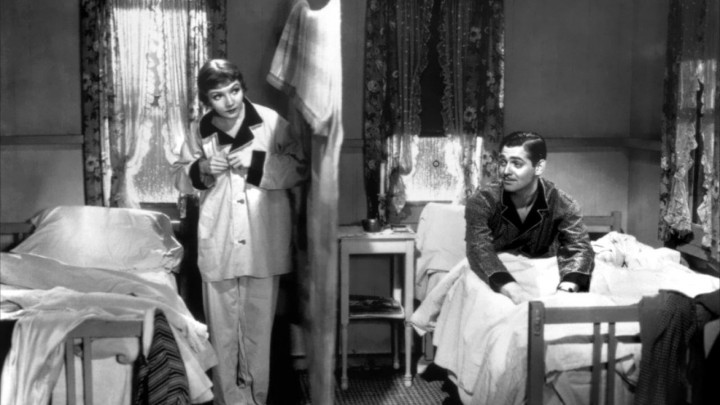
1934. It Happened One Night.
The first of only three films to-date to win the Big Five Academy Awards – Picture, Director, Actor, Actress, and Writing – It Happened One Night has become a classic “screwball” comedy archetype and a hugely lauded classic of the genre. Starring Clark Gable and Claudette Colbert as an on-the-run couple, the film was seen as a second-tier project by almost all involved until it’s escapist themes began to resonate with the rural gentry of America’s middle-class. Legend has it that Colbert, who was nominated for Best Actress, was so sure she’d never win and so booked a train trip out of town on Oscar night, only suddenly find herself dragged off the platform by her agent and raced to the Oscar ceremony where she picked up her gong dressed in her going-away suit. Although my own thoughts on the film seem counter to the status of this film’s place in history, this doesn’t prevent me from recognising it as one of the most acclaimed films in the Golden Age.
Also in 1934: The Production Code. The Motion Picture Production Code (often shortened to the Hayes Code, after the President of the MPPDA Will H Hays) started life in 1930, as a series of industry regulations as to what could and could not be included on screen in a feature film. In 1934, with growing public unrest over increasingly lewd, salacious and boundary-pushing films being released, the Code was revised significantly to prevent moral degradation of American society (heh!) overseen by Joseph Breen; the code strictly forbade a large variety of themes including profanity, sex, racism and racial integration, ridicule of the clergy (so no priest jokes), and even scenes of childbirth (visual or implied). Perhaps most famously, the Code also gave rise to the notion that married couples should sleep in separate beds. Heh heh. All films released in America had to carry the Code’s seal of approval before cinema chains would screen them.
1935. Top Hat
Arguably the best of Fred Astaire and Ginger Rogers’ on-screen pairings, Top Hat was the 3rd highest earner of the year and identified by memorable songs from Irving Berlin, including “Cheek To Cheek”. In terms of Hollywood duos, none could top the singing-and-dancing pair for sheer box-office clout, and as a production overall, it’s hard to fault Top Hat even today.
Also in 1935: Mutiny On The Bounty would win Best Picture, Hitchcock’s The 39 Steps was released, as were cinematic classics Bride Of Frankenstein, Hop-Along Cassidy, Triumph of The Will, and Anna Karenina. Pricewaterhouse Coopers would begin managing the Academy Award balloting process (and have ever since), MGM’s Audioscopiks would be the first 3D film nominated for an Oscar, and the first major production of a Shakespeare play, A Midsummer Night’s Dream, would land in cinemas to considerable acclaim. Twentieth Century Pictures and Fox Film Corp would amalgamate to become 20th Century Fox, and The Marx Brothers would appear in their first MGM movie, the hit comedy A Night At The Opera.
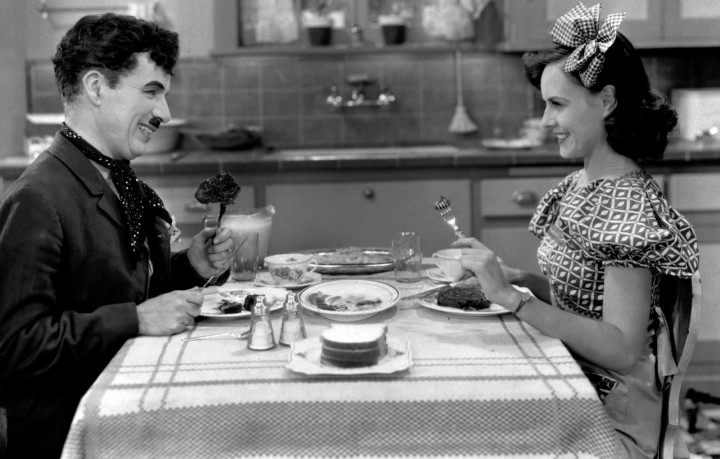
1936. Modern Times
Chaplin’s famous stab at progress might lack the jagged barbs of 1930’s capitalist inhumanity, and it seems ill-advised as a statement against the burgeoning concept of “talkies” as it was back then, but Modern Times is a remarkable, nay, iconic piece of cinematic literature. It became the third-highest box-office earner of the year. You can read my review here, but the short of it is that Chaplin’s final film as the Tramp character is a piece of absolute rolled-gold film-making; clever, funny, riotously inventive and always carrying a meaning beyond the faux-silent aesthetic (the film was primarily a silent film with minor sound effects and vocals in some parts). For both the concluding chapter in one of the most recognisable characters in film, and for its place as a piece of commentary of society and life of its age, Modern Times is essential, unmissable cinema.
Also in 1936: The first 3D talkie film, the Italian produced Beggar’s Wedding (aka Nozze Vagabonde) was produced, with audiences using polarized glasses to achieve the dimensional effect, was released, and the first shot-entirely-on-location technicolor film, The Trail of Lonesome Dove, starring Henry Fonda, arrived. MGM’s The Great Ziegfeld snagged Best Picture, Errol Flynn and Olivia de Haviland warred it up in The Charge Of The Light Brigade, and the cult classic Reefer Madness was released. The Screen Actors Guild (SAG) was formed, with legendary director King Vidor being voted in as its first president. On the serial front, Flash Gordon arrived in cinemas in the first of a thirteen-part adventure, while The Green Hornet, based on the comic strip, appeared in both serial form and in radio format.
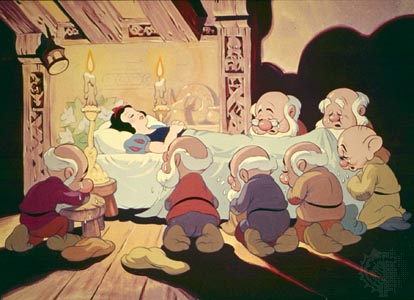
1937. Snow White & The Seven Dwarfs
Cynics scoffed at Disney’s ambitious feature-length animated film – the world’s first – saying that audiences would never want to sit through, nor pay for, a feature length cartoon. How wrong those people were: Snow White was made for the princely sum of $1.5 million, and would go on to slay the box-office recouping over $8m in receipts, making it the most successful film of the year. Not only would the film captivate audiences and provide Walt Disney with the momentum to turn his then fledgeling studio into an industry behemoth, but it would also be the first film in history to release an official soundtrack album. It legitimized animation, commoditized it, and naturally once Snow White became successful audiences clamoured for more. The film featured the iconic “Hi Ho, Hi Ho” song (sung by the titular tiny people) and popularized the now archetypal Wicked Witch, Magic Mirror and beautiful princess/handsome prince motif films have copied with such vigour ever since. Even today it remains an astonishingly beautiful piece of animated artistry, for the delicacy of its style and aesthetic superiority of its production value.
Also in 1937: The Life Of Emile Zola would win Best Picture at the Academy Awards, while Luise Rainer became the first person to win multiple Best Actress Oscars back-to-back for her work in 1936’s The Great Ziegfeld and 1937’s The Good Earth. Daffy Duck made a nascent début in Warner’s Porky’s Duck Hunt short, Clark Gable and Myrna Loy were voted King And Queen of Hollywood by a ballot of national newspapers, while Jean Harlow, co-star with Gable in 1937’s Saratoga, passed away on June 7th, aged just 26, from uremic poisoning. Mickey Rooney and Judy Garland would pair up for the first time in Thoroughbred’s Don’t Cry, and Shirley Temple’s Heidi landed in cinemas as well.
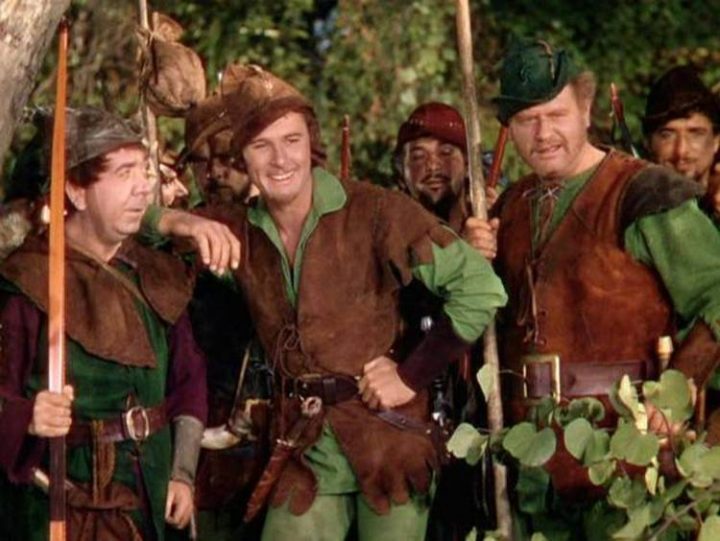
1938. The Adventures Of Robin Hood
In the 30’s, Errol Flynn was a huge star, an Aussie boy made good. The zenith of his career popularity came with 1938’s Robin Hood, a swashbuckling adventure film that delighted audiences worldwide, and made Flynn a household name. Although the film would not win Best Picture, nor be the highest box-office earner of that year, The Adventures of Robin Hood’s legacy has largely overshadowed many of its contemporaries from 1938, and remains not only Flynn’s best film, but the most memorable film from this period.
Also in 1938: Disney’s animated short, Ferdinand The Bull, arrived, and became an instant classic. Orson Welles’ infamous radio broadcast of HG Wells’ The War of The Worlds took place, and soon-to-be-famous cinema cowboy Roy Rogers made his film debut in Under Western Stars. Bugs Bunny debuted in the Warner Bros short Porky’s Hare Hunt, while screen duo Fred Astaire and Ginger Rogers would share their first and only on-screen kiss in Carefree. In the legal world, Coogan’s Law (named after Jackie Coogan, who had appeared opposite Charlie Chaplin in The Kid) was enacted, establishing a protocol for payment and fund management for child actors, following Coogan’s suing of his parents for spending all the money he’d earned appearing in films. You Can’t Take It With You won Best Picture at the Oscars, while Spencer Tracy would win his second consecutive Best Actor Oscar for Boys Town, following his win in the same category for Captains Courageous the previous year.
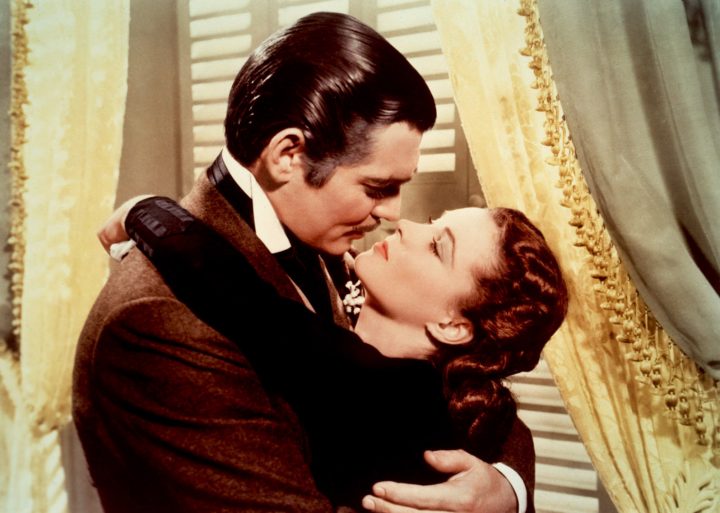
1939. Gone With The Wind
You could throw a blanket over the group of worthy 1939 films which could appear in this spot, and still miss some. Some might argue The Wizard of Oz deserves its time here, due to its enduring popularity, while fellow Best Picture nominees such as Mr Smith Goes To Washington, Stagecoach, Wuthering Heights, and even the popular (but historically inaccurate) Tyrone Power adventure flick Jesse James have a stake in their status as landmark films of the year. But Gone With The Wind, the eventual Best Picture winner, stands tall among the collective: it won a then-record 8 Oscars, including the first for an African-American actress in Hattie McDaniel (also the first African-American to be nominated) in the Best Supporting Actress category, and was the first Best Picture shot in colour, while purportedly having a wallet-busting budget of around $4 million, scooped a massive $200m (domestic) at the box office. It was at the time the most expensive film ever in Hollywood, as well as the longest. The film starred Clark Gable and then-unknown British actress Vivien Leigh, and provided audiences with one of the greatest closing lines in cinema history – “Frankly my dear, I don’t give a damn!”.
Also in 1939: Phew – er, The Wizard Of Oz, starring Judy Garland and her tiny dog and some fabulous visuals, landed in cinemas, as did John Ford’s classic Stagecoach, while the list of other notable classics from the year include Destry Rides Again, Gunga Din, Goodbye Mr Chips, Of Mice And Men, The Women and The Hunchback Of Notre Dame. Basil Rathbone appeared in the first of his many Sherlock Holmes films, in 1939’s The Hound Of The Baskervilles, while a newfangled invention – television – debuted at New York’s World’s Fair. Orson Welles would sign a remarkable multi-film contract with RKO, giving his enormous creative control over his projects following the events of his War of The Worlds radio broadcast, and one of Hollywood’s “first fathers”, Douglas Fairbanks Sr, died of a heart attack aged 56. In non-Wizard news, Judy Garland and Mickey Rooney would appear in the first of four “backyard” musicals, entitled Babes In Arms, in 1939.

I've seen a few more films from this decade than the previous ones: Snow White, King Kong, Wizard of Oz, Robin Hood, Dracula, and Frankenstein. It truly seems to have been a landmark time for cinema. Thanks again for the informative post, Rodney, I look forward to the next one.
As I've been working on this series I've tried to catch up on watching some of the films I mention, and it's been a great way of widening my knowledge on some of Hollywood's vintage output. Glad you're enjoying this series, dude!
I've actually seen one of these films: Snow White! Gone With The Wind and Modern Times are certainly on the watchlist though.
TBH, just about every Charlie Chaplin film I've seen thus far should be on everyone's watchlist. Modern Times is just brilliant, though.